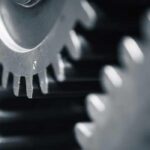Introduction
The slip and creep in the belt or rope drives is a common phenomenon, in the transmission of motion or power between two shafts. The effect of slip is to reduce the velocity ratio of the drive. In precision machine, in which a definite velocity ratio is importance (as in watch mechanism, special purpose machines..etc), the only positive drive is by means of gears or toothed wheels.
Gears are machine elements that transmit motion by means of successively engaging teeth. The gear teeth act like small levers. Gears are highly efficient (nearly 95%) due to primarily rolling contact between the teeth, thus the motion transmitted is considered as positive. Gears essentially allow positive engagement between teeth so high forces can be transmitted while still undergoing essentially rolling contact. Gears do not depend on friction and do best when friction is minimized.
Let the wheel A be keyed to the rotating shaft and the wheel B to the shaft, to be rotated. A little consideration will show, that when the wheel A is rotated by a rotating shaft, it will rotate the wheel B in the opposite direction as shown in Fig. 4.1 (a). The wheel B will be rotated (by the wheel A) so long as the tangential force exerted by the wheel A does not exceed the maximum frictional resistance between the two wheels. But when the tangential force (P) exceeds the frictional resistance (F), slipping will take place between the two wheels. Thus the friction drive is not a positive drive.

Fig. 4.1.
In order to avoid the slipping, a number of projections (called teeth) as shown in Fig. 5.1 (b), are provided on the periphery of the wheel A, which will fit into the corresponding recesses on the periphery of the wheel B. A friction wheel with the teeth cut on it is known as toothed wheel or gear. The usual connection to show the toothed wheels is by their pitch circles.


